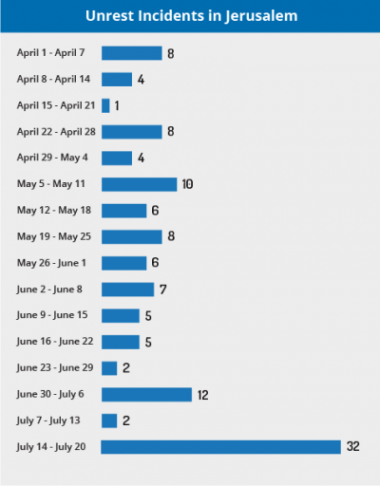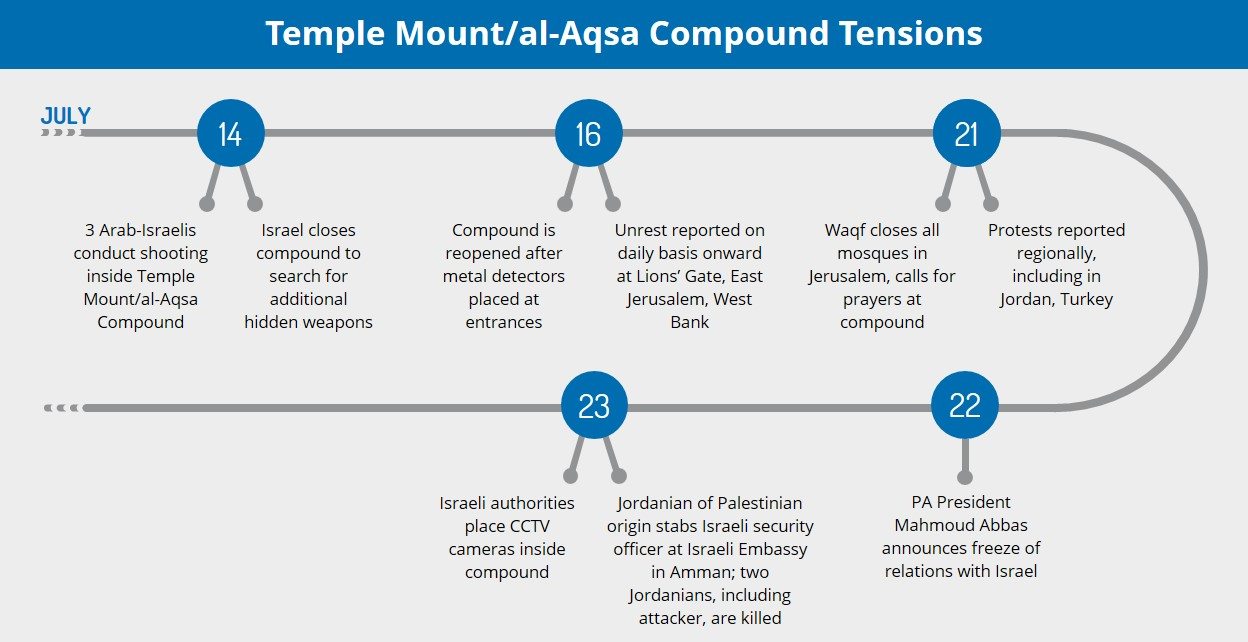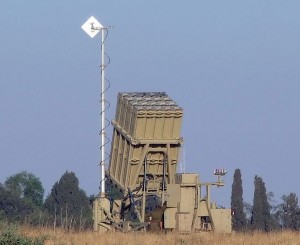Background & Current Situation
Background of Incident
On July 14, three Arab-Israelis conducted a shooting attack inside the Temple Mount/al-Aqsa Compound in Jerusalem, in which they killed two Israeli Policemen and wounded a third. All three militants were subsequently shot and killed. In the aftermath of the attack, Israel closed the compound to all visitors in order to search it for additional weapons that may have been hidden on the premises. The compound was reopened by Israel on July 16 after metal detectors were placed at its entrances. Additionally, during the overnight hours of July 22-23, Israeli authorities placed closed-circuit television (CCTV) cameras inside the compound as added security measures to prevent future attacks.
Response by Arab Leaders
The Arab and Muslim world widely condemned these added security measures, claiming that they were an Israeli attempt to alter the status quo at the religious site. As a result, the Jerusalem Islamic Waqf closed all mosques in Jerusalem on July 21 and called all Muslims to instead hold mass prayers in the Temple Mount/al-Aqsa Compound. In response, Israel allowed only women and men over the age of 50 to access the Old City on that day in order to mitigate the threat of unrest. Furthermore, on July 22, the President of the Palestinian Authority Mahmoud Abbas announced that the PA “froze all relations with Israel in response to the measures in Jerusalem”. Meanwhile, Hamas, which praised the July 14 attack, criticized the PA’s announced measures as “ineffective”.
Unrest in Jerusalem and West Bank
Nonetheless, since July 16, clashes at varying intensities between Palestinian protesters and Israeli security forces have taken place on a near-daily basis in the vicinity of the Lions’ Gate in Jerusalem’s Old City. Additionally, there has been a significant uptick in incidents of unrest in East Jerusalem and the Palestinian Territories. During the week of July 14-20, 32 instances of unrest were recorded in East Jerusalem, compared to an average of approximately six such incidents per week in the preceding four months.
Demonstrations in MENA Region
Moreover, demonstrations over this issue took place in several locations in the region. This was most prominent in Jordan’s Amman, where weekly Friday protests drew gatherings in the high-hundreds, and in Turkey, including in major cities such as Istanbul, Ankara, and Izmir, with crowds in the low hundreds in each event. Additional small scale demonstrations took place in Bahrain and Morocco.
Lone-wolf attacks following the event
Lastly, On July 21, three Israelis were killed when a militant entered their house in the West Bank Israeli town of Halamish. Additionally, on July 23 a Jordanian of Palestinian origin stabbed an Israeli security officer inside the Israeli Embassy compound in Amman, Jordan, and was subsequently shot and killed along with a bystander. Finally, on July 24 a Palestinian conducted a stabbing attack in Petah Tikva, Israel, and claimed to have done so “for al-Aqsa”.
Assessments & Forecast
While the events in Jerusalem garnered significant attention in the Arab and Muslim world and led to major incidents of unrest, unless unexpected events unfold, it is likely that the situation will be resolved in the coming days or weeks, particularly as it is in the interest of the majority of the actors involved in the process.
In this context, Israel likely has no interest in causing an escalation in violence with the Palestinians, as well as with the Arab and Muslim world as a whole. That said, this is unlikely to deter Israel from ensuring that security is maintained in the compound, especially after the recent attacks and subsequent domestic criticism on lack of effective security at such a sensitive locale. Similarly, an escalation would be counter to the interests of the PA, as such a development will likely empower Hamas at the expense of the PA, and will threaten the latter’s hold in the West Bank. As a result, Abbas’ announcement of “freezing all relations with Israel” was likely meant to pertain to the hardliners in the West Bank and offset any potential influence by Hamas, and to a degree, serve as leverage against Israel, rather than being an effort to encourage additional hostilities.
A political solution regarding the situation in the Temple Mount/al-Aqsa Compound will likely be reached in the coming days or weeks with mediation by the US and Jordan. Such a solution may include the complete removal of metal detectors at the compound, while the CCTV cameras, or an alternative means of monitoring the security situation at the site, remain in place. This is particularly likely as Israel demanded that such monitoring devices should be placed at the compound for months before the recent hostilities started, but was rejected by the Waqf due to claims that this will compromise the status quo at the site. Such a compromise may leave both sides content, as the PA will achieve the symbolic victory of having the metal detectors removed, which have become a symbol of the recent hostilities, while Israel will maintain the additional security measures that it had previously sought.
Meanwhile, the incident in Jordan may cause diplomatic complications between the Hashemite Kingdom and Israel, and therefore, may adversely affect negotiations as Jordan de-facto controls the Jerusalem Islamic Waqf, which has authority over the Temple Mount/al-Aqsa Compound. Nonetheless, it is in the interest of Jordan as well to prevent a further escalation in hostilities. Therefore, any effect that the situation may have will likely be limited to prolonging the negotiations and possibly forcing Israel into making further concessions.
Regionally, unrest revolving around the issue has likely reached its peak and such demonstrations are beginning to lose momentum. With this in mind, demonstrations will likely continue until the political issue is resolved, however, will gradually decline in their scope and scale, and will mostly affect Turkey and Jordan, the latter mainly on Fridays which are the preferred day of such gatherings. Additionally, in the period leading to the eventual likely agreement, the threat of low-level, “lone-wolf” attacks against Israeli or Israeli-affiliated targets, similar to that witnessed in Jordan on July 23, will be heightened, but will likely revert following the eventual settling of the issue. Furthermore, there is an increased threat of lone-wolf attacks in general, particularly in Western Europe, by individuals motivated by the perceived violation of the Temple Mount/al-Aqsa Compound and claims of harm against the holy site.
Locally, in Israel and the Palestinian Territories, incidents of unrest are likely to experience a similar trend as the regional ones, with the coming Friday possibly experiencing a last peak in such activities before these gradually reduce until the conclusion of the political issue. The only likely exception to this is East Jerusalem, where protests and acts of unrest are likely to persist at a high rate in the coming weeks, as the population in this area is under greater influence from Islamist organizations, compared to mainstream political ones like the PA, and may not be satisfied with any potential compromise.
In terms of militancy, the coming weeks will likely continue to witness a relative heightened rate of “lone-wolf” attacks against Israelis, mostly consisting of stabbing, vehicular, Molotov cocktail, and low-level shooting attacks, focusing on Jerusalem, the West Bank, and to a lesser degree, Israel. While these are likely to eventually reduce in their scope and scale, given precedent, it remains possible that they will persist at a high rate, causing a lingering heightened threat of militancy over the coming months. Furthermore, while it is in the interest of Hamas to cause an escalation in the West Bank as mentioned above, a significant escalation of hostilities in the Gaza Strip will be against the organization’s interests as a potential Israeli response will pose a significant threat to it, and is therefore unlikely to take place. Nonetheless, limited attacks, mostly in the form of low-level and short range surface-to-surface rockets against Israel, will likely be initiated at a relatively higher rate by Salafist militant groups based in the Gaza Strip.
Recommendations
Israel
Travel to Israel may continue at this time while adhering to security precautions regarding militant attacks, while avoiding the immediate vicinity of the Syrian, Lebanese, and Egyptian borders, due to the persistent risk for cross border violence. Those traveling in the 40 km area surrounding the Gaza Strip should continue adhering to all safety precautions regarding early warning sirens for incoming rockets. In case you hear a siren, seek shelter in a protected area and remain inside for at least 10 minutes.
In major Israeli cities, remain vigilant in crowded commercial areas or public transport hubs, as these locations have been targeted by militant groups in the past. Alert authorities to suspicious, unattended packages in these areas. As a general precaution, avoid nonessential travel to the vicinity of Jerusalem’s Old City, particularly in the vicinity of Lions’ Gate, due to the reported clashes and a recent heightening of tensions between East Jerusalem residents and Israeli security forces.
Palestinian Territories
Business-essential travel to Ramallah can continue at this time while adhering to basic security precautions regarding the threats of civil unrest and militancy. Consult with us for itinerary-based recommendations and ground support options. Avoid nonessential travel to other Palestinian-controlled areas of the West Bank at this time given the persistent threat of civil unrest. We advise against all travel to the Gaza Strip at this time due to continuous border crossing closures and the threat of militant activity. If travel is essential, prior to entering Palestinian-controlled areas from Jerusalem-area checkpoints, confirm that crossings remain open and no unrest is taking place. Crossings near the cities of Jenin, Qalqilya, and Tul Karem remain less prone to violence.
Regional
Maintain heightened vigilance given the potential for demonstrations and associated acts of unrest related to the Temple Mount/al-Aqsa Compound tensions. Avoid the vicinity of any such gatherings. Additionally avoid the immediate vicinity of Israeli diplomatic missions, due to the increased risk for acts of militancy targeting these locales. Contact us at [email protected] or +44 20-3540-0434 for itinerary and contingency support plans.


